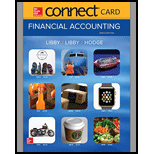
Connect Access Card for Financial Accounting
9th Edition
ISBN: 9781259738678
Author: Robert Libby, Patricia Libby, Frank Hodge Ch
Publisher: McGraw-Hill Education
expand_more
expand_more
format_list_bulleted
Question
Chapter 10, Problem 10.2AP
To determine
Complete the given table.
Expert Solution & Answer
Want to see the full answer?
Check out a sample textbook solution
Students have asked these similar questions
The amount of overr pr under applied overhead for the month was ?
Solve this
Ansari Basketball Inc. had a player contract with Rodriguez that is recorded in its books at $3,500,000 on July 15, 2022. Delta Basketball Inc. had a player contract with Williams that is recorded in its books at $4,200,000 on July 15, 2022. On this date, Ansari traded Rodriguez to Delta for Williams and paid a cash difference of $800,000. The fair value of the Williams contract was $5,300,000 on the exchange date. The exchange had no commercial substance. After the exchange, the Williams contract should be recorded in Ansari's books at $ __? Answer
Chapter 10 Solutions
Connect Access Card for Financial Accounting
Ch. 10 - From the perspective of the issuer, what are some...Ch. 10 - What are the primary characteristics of a bond?...Ch. 10 - Prob. 3QCh. 10 - Differentiate between a bond indenture and a bond...Ch. 10 - Prob. 5QCh. 10 - Prob. 6QCh. 10 - Prob. 7QCh. 10 - Prob. 8QCh. 10 - What is the book value of a bond?Ch. 10 - Prob. 10Q
Ch. 10 - Prob. 11QCh. 10 - Prob. 12QCh. 10 - Prob. 1MCQCh. 10 - Prob. 2MCQCh. 10 - Prob. 3MCQCh. 10 - Prob. 4MCQCh. 10 - Prob. 5MCQCh. 10 - Prob. 6MCQCh. 10 - Prob. 7MCQCh. 10 - Prob. 8MCQCh. 10 - Prob. 9MCQCh. 10 - Prob. 10MCQCh. 10 - Prob. 10.1MECh. 10 - Computing the Price of a Bond Issued at Par LO10-2...Ch. 10 - Understanding Financial Ratios 0-3, 10-6 The...Ch. 10 - Computing the Times Interest Earned Ratio LO10-3...Ch. 10 - Computing the Price of a Bond Issued at a Discount...Ch. 10 - Recording the Issuance and Interest Payments of a...Ch. 10 - Prob. 10.7MECh. 10 - Prob. 10.8MECh. 10 - Prob. 10.9MECh. 10 - Prob. 10.10MECh. 10 - Prob. 10.11MECh. 10 - Prob. 10.12MECh. 10 - Prob. 10.13MECh. 10 - Prob. 10.14MECh. 10 - Prob. 10.1ECh. 10 - Prob. 10.2ECh. 10 - Prob. 10.3ECh. 10 - Computing Issue Prices of Bonds Sold at Par, at a...Ch. 10 - Prob. 10.5ECh. 10 - Prob. 10.6ECh. 10 - Prob. 10.7ECh. 10 - Prob. 10.8ECh. 10 - (Chapter Supplement) Recording and Reporting a...Ch. 10 - Prob. 10.10ECh. 10 - Prob. 10.11ECh. 10 - Explaining Why Debt Is Issued at a Price Other...Ch. 10 - Prob. 10.13ECh. 10 - Prob. 10.14ECh. 10 - Prob. 10.15ECh. 10 - Prob. 10.16ECh. 10 - Prob. 10.17ECh. 10 - Prob. 10.18ECh. 10 - Prob. 10.19ECh. 10 - Prob. 10.20ECh. 10 - Prob. 10.21ECh. 10 - Prob. 10.22ECh. 10 - Prob. 10.23ECh. 10 - Prob. 10.24ECh. 10 - Prob. 10.1PCh. 10 - Prob. 10.2PCh. 10 - Comparing Bonds Issued at Par, at a Discount, and...Ch. 10 - Prob. 10.4PCh. 10 - Prob. 10.5PCh. 10 - Recording and Reporting Bonds Issued at a Discount...Ch. 10 - Recording and Reporting a Bond Issued at a...Ch. 10 - Prob. 10.8PCh. 10 - Prob. 10.9PCh. 10 - Prob. 10.10PCh. 10 - Prob. 10.11PCh. 10 - Prob. 10.12PCh. 10 - Prob. 10.13PCh. 10 - Prob. 10.14PCh. 10 - Prob. 10.15PCh. 10 - Prob. 10.16PCh. 10 - Prob. 10.1APCh. 10 - Prob. 10.2APCh. 10 - Prob. 10.3APCh. 10 - Prob. 10.4APCh. 10 - Prob. 10.5APCh. 10 - Prob. 10.6APCh. 10 - Recording and Reporting a Bond Issued at a Premium...Ch. 10 - Prob. 10.8APCh. 10 - Prob. 10.1CONCh. 10 - Prob. 10.1CPCh. 10 - Prob. 10.2CPCh. 10 - Prob. 10.3CPCh. 10 - Prob. 10.4CPCh. 10 - Prob. 10.5CPCh. 10 - Evaluating an Ethical Dilemma LO 10-1 Assume that...
Knowledge Booster
Similar questions
- Pristine Printing's cost formula for its materials cost is $2,150 per month plus $18 per book. For the month of December, the company planned for activity of 725 books, but the actual level of activity was 698 books. The actual materials cost for the month was $14,875. The variance for materials cost in December would be _.arrow_forwardMagnetron Inc. reports a total contribution margin of $135,000 and pretax net income of $27,000 for the current month. The degree of operating leverage is __.arrow_forwardAccurate answerarrow_forward
- Donovan Manufacturing has an overhead application rate of 145% and allocates overhead based on direct material cost. During the current period, direct labor cost is $63,500 and direct materials used cost is $82,000. Determine the amount of overhead Donovan Manufacturing should record in the current period.arrow_forwardPlease provide the accurate answer to this general accounting problem using valid techniques.arrow_forwardAt an output level of 46,000 units, Falstaff Industries calculates that the degree of operating leverage is 2.1. If output rises to 67,850 units, what will be the percentage change in operating cash flow?arrow_forward
arrow_back_ios
SEE MORE QUESTIONS
arrow_forward_ios
Recommended textbooks for you
 Excel Applications for Accounting PrinciplesAccountingISBN:9781111581565Author:Gaylord N. SmithPublisher:Cengage Learning
Excel Applications for Accounting PrinciplesAccountingISBN:9781111581565Author:Gaylord N. SmithPublisher:Cengage Learning Cornerstones of Financial AccountingAccountingISBN:9781337690881Author:Jay Rich, Jeff JonesPublisher:Cengage LearningPrinciples of Accounting Volume 1AccountingISBN:9781947172685Author:OpenStaxPublisher:OpenStax College
Cornerstones of Financial AccountingAccountingISBN:9781337690881Author:Jay Rich, Jeff JonesPublisher:Cengage LearningPrinciples of Accounting Volume 1AccountingISBN:9781947172685Author:OpenStaxPublisher:OpenStax College Financial Accounting: The Impact on Decision Make...AccountingISBN:9781305654174Author:Gary A. Porter, Curtis L. NortonPublisher:Cengage Learning
Financial Accounting: The Impact on Decision Make...AccountingISBN:9781305654174Author:Gary A. Porter, Curtis L. NortonPublisher:Cengage Learning

Excel Applications for Accounting Principles
Accounting
ISBN:9781111581565
Author:Gaylord N. Smith
Publisher:Cengage Learning

Cornerstones of Financial Accounting
Accounting
ISBN:9781337690881
Author:Jay Rich, Jeff Jones
Publisher:Cengage Learning

Principles of Accounting Volume 1
Accounting
ISBN:9781947172685
Author:OpenStax
Publisher:OpenStax College


Financial Accounting: The Impact on Decision Make...
Accounting
ISBN:9781305654174
Author:Gary A. Porter, Curtis L. Norton
Publisher:Cengage Learning